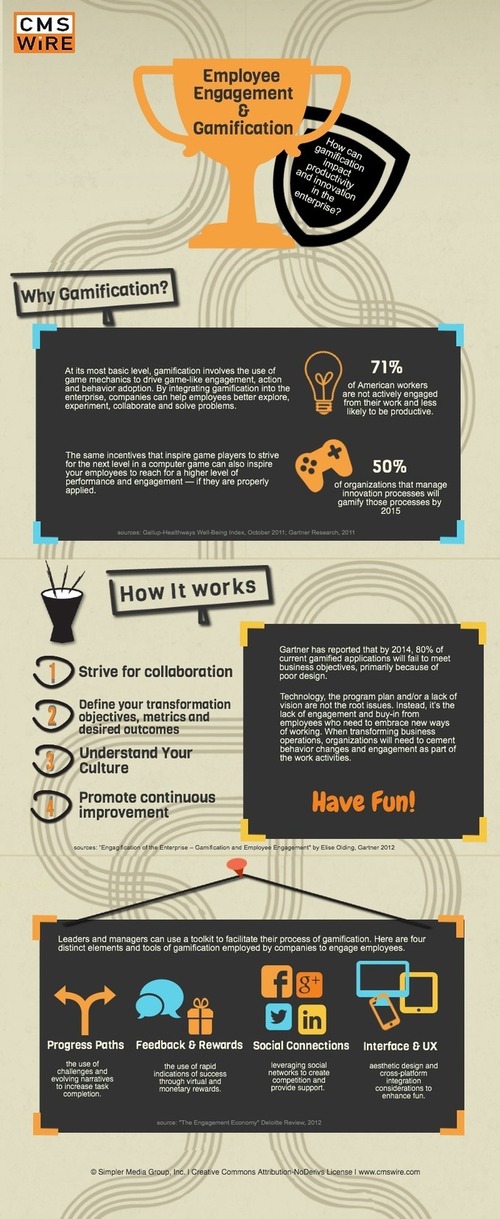How Gamification Can Impact Employee Engagement [Infographic]

Why Gamification?
When done correctly, gamification can inspire, motivate and help team members collaborate more effectively and more organically overtime. And face it, most us need to feel inspired and could use to be motivated about work, these days. In fact, according to the recent Gallup-Healthways Well Being Index, seventy-one percent of American workers are not actively engaged at work and as a result are less likely to be productive. Lack of productivity doesn’t just mean lack of innovation or decreased revenues, it also means lower morales and bad attitudes.
Earlier this week, Jason Silberman talked about the pros and cons of game mechanics, in which he calls gamification “one of the more interesting and unique organizational learning strategies that are worth considering trying.” And many companies are wading into the gamification waters. In fact, in just three years Gartner predicts that those companies who are focused on increased and improved innovation, more than half will have gamified their processes.
How Gamification Works
There is no one-size-fits-all strategy for turning work into games. Additionally, not all work needs to be a game. It’s important for companies to not only understand the outputs that need work, but the impact that their company culture has on those outputs. At the widget factory, for instance, if the number of widgets being made are not meeting demand, handing out rewards for those who can make the most widgets in a hour probably won’t help the company if the reason people are slow is because a piece of machinery is broken, or they’re waiting for quality control to review their work.
What is it that you want to accomplish by gamifying your workflow? If it’s to boost morale, it’s best to take a closer look at who your employees are and what has impacted their company outlook. Sometimes, you might be able to turn things around simply by offering more vacation days or flexible work schedules, than if you tried to force them to play games. Of course, if your employees are stuck in a rut, some meaningful “game-like” activities may help them look at things from different perspectives and breathe new life into projects.
How Gamification Works
There is no one-size-fits-all strategy for turning work into games. Additionally, not all work needs to be a game. It’s important for companies to not only understand the outputs that need work, but the impact that their company culture has on those outputs. At the widget factory, for instance, if the number of widgets being made are not meeting demand, handing out rewards for those who can make the most widgets in a hour probably won’t help the company if the reason people are slow is because a piece of machinery is broken, or they’re waiting for quality control to review their work.
What is it that you want to accomplish by gamifying your workflow? If it’s to boost morale, it’s best to take a closer look at who your employees are and what has impacted their company outlook. Sometimes, you might be able to turn things around simply by offering more vacation days or flexible work schedules, than if you tried to force them to play games. Of course, if your employees are stuck in a rut, some meaningful “game-like” activities may help them look at things from different perspectives and breathe new life into projects.
See on www.cmswire.com
Matmi‘s insight:
“Our experience with the gamified product RedCritter has been nothing but a positive one. We have found that the points system within Red Critter really motivates staff to work harder and earn more points to get more rewards! Gamification at its best.”
What employee wouldn’t be motivated by the thought of winning fantastic rewards such as gift vouchers, remote control helicopters and chocolate?
March 2013